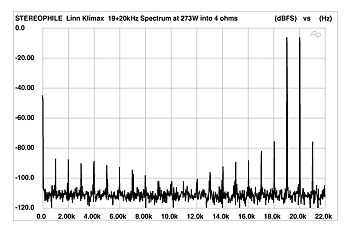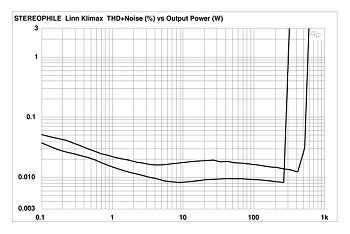| Columns Retired Columns & Blogs |
Linn Klimax 500 Solo monoblock power amplifier Measurements part 3
Fig.6 shows the output spectrum resulting from a combined 19+20kHz signal—it shows the intermodulation products resulting from an input signal consisting of an equal combination of these two frequencies—at 273W into 4 ohms. Visible clipping is present above this output with this signal. The resulting IM distortion at 1kHz is under -86dB (0.005%); the highest component, at 18kHz, is -82dB (just under 0.01%). The corresponding measurement at 145W into 8 ohms (not shown) indicates even lower levels of IM distortion.

Fig.6 Linn Klimax 500 Solo, HF intermodulation spectrum, DC-22kHz, 19+20kHz at 273W into 4 ohms (linear frequency scale).
The curves for 1kHz THD+noise vs output are shown in fig.7, where the Klimax's high power output is evident. You will see no curve for the 2 ohm condition; the Klimax blew its main power-supply fuse before a plot could be made. The same fuse blew when I attempted to take the Linn's discrete power output into a 4 ohm load. The only discrete reading obtained was therefore into an 8 ohm load: 299.5W into 8 ohms (24.8 dBW) at 1% THD+noise (114V power line). It wasn't possible to perform any pulse power testing using the Miller Audio Research Amplifier Profiler, there apparently being some incompatability between the Linn's output stage and the analyzer's singled-ended input.

Fig.7 Linn Klimax 500 Solo, distortion (%) vs continuous output power into 8 ohms, 4 ohms, 2 ohms, and 1 ohm.
Except for its perhaps overprotective main fuse, the Linn Klimax's test-bench results are first-class.—Thomas J. Norton
- Log in or register to post comments




































